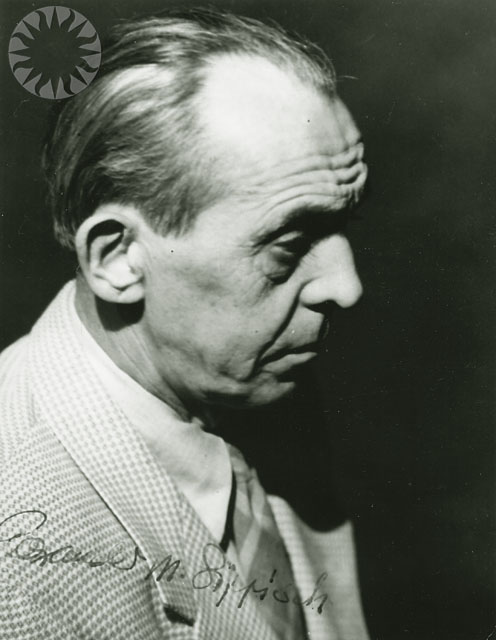- Alexander Lippisch
Infobox Engineer

image_width = 150px
caption = Alexander Martin Lippisch (1894-1976)
name = Alexander Lippisch
nationality =German
birth_date =November 2 ,1894
birth_place =Munich ,German Empire
death_date =February 11 ,1976
death_place = Cedar Rapids,Iowa ,U.S.A.
education =
spouse =
parents =
children =
discipline =
institutions =
practice_name =
significant_projects =Messerschmitt Me 163
significant_design =
significant_advance =aerodynamics
significant_awards =Alexander Martin Lippisch (
November 2 ,1894 –February 11 ,1976 ) was a German pioneer ofaerodynamics . He made important contributions to the understanding offlying wing s,delta wing s and theground effect . His most famous design is theMesserschmitt Me 163 rocket-powered interceptor.Lippisch was born in
Munich ,Kingdom of Bavaria . He later recalled that his interest in aviation stemmed from a demonstration conducted by Orville Wright, over Tempelhof Field inBerlin , in September 1909. [ [http://www.centennialofflight.gov/essay/Wright_Bros/Military_Flyer/WR11G1.htm Wright Flyer over Templehoff] ] Nonetheless, he planned to follow his father’s footsteps into art school. The outbreak ofWorld War I intervened. During his service with the German Army from 1915–1918, Lippisch had the chance to fly as an aerial photographer and mapper.Following the war, Lippisch worked with the Zeppelin Company, and it was at this time that he first became interested in tail-less aircraft. In 1921 his first such design would reach production in as the
Lippisch-Espenlaub E-2 glider, built byGottlob Espenlaub . This was the beginning of a research programme that would result in some fifty designs throughout the 1920s and 1930s. Lippisch’s growing reputation saw him appointed the director of theRhön-Rossitten Gesellschaft (RRG), a glider research group.Lippisch’s work led to a series of tail-less designs numbered Storch I – Storch IX between 1927 and 1933 (these were not related to the successful Fieseler Fi 156 Storch STOL aircraft of WW2). These designs attracted little interest from the government and private industry. Nonetheless, it was during this time that Lippisch’s
Ente ("Duck") became the first aircraft to fly underrocket power.Experience with the Storch series led Lippisch to concentrate increasingly on delta-winged designs. This interest resulted in five aircraft, numbered Delta I – Delta V, which were built between 1931 and 1939. In 1933, RGG had been reorganised into the "Deutsche Forschungsanstalt für Segelflug" (DFS — "German Institute for Sailplane Flight") and the Delta IV and Delta V were designated as the
DFS 39 andDFS 40 respectively.In early 1939, the "Reichsluftfahrtsministerium" (RLM — “Reich Aviation Ministry”) transferred Lippisch and his team to work at the
Messerschmitt factory, in order to design a high-speedfighter aircraft around the rocket engines then under development byHellmuth Walter . The team quickly adapted their most recent design, theDFS 194 , to rocket power, the first example successfully flying in early 1940. This was the direct ancestor of what would become the Messerschmitt Me 163 "Komet".Although technically novel, the Komet did not prove to be a successful weapon, and friction between Lippisch and Messerschmitt was frequent. In 1943, Lippisch transferred to Vienna’s "Luftfahrtforschungsanstalt Wien" (LFW), to concentrate on the problems of high-speed flight. That same year, he was awarded a doctoral degree in engineering by the
University of Heidelberg .Wind tunnel research in 1939 had suggested that the delta wing was a good choice forsupersonic flight, and Lippisch set to work designing a supersonic,ramjet -powered fighter, theLippisch P.13a . [http://www.youtube.com/watch?v=MvtxjSrImHw wartime test footage] By the time the war ended, however, the project had only advanced as far as a development glider, the DM-1.Like many German scientists, Lippisch was taken to the
United States after the war underOperation Paperclip . Advances in jet engine design were making Lippisch's ideas more practical, andConvair became interested in a hybrid jet/rocket design which they proposed as the F-92. [http://www.wpafb.af.mil/museum/research/fighter/f92.htm] In order to gain experience with the delta wing, they first built a jet powered test aircraft, the 7003, which became the first powered delta-wing aircraft to fly. Although theUSAF lost interest in the F-92, the 7003 was designated theXF-92A which gave Convair experience with the delta-wing design. This led them to proposing it for most of their projects through the 1950s and into the 1960s, including theF-102 Delta Dagger ,F-106 Delta Dart andB-58 Hustler .From 1950–1964 Lippisch worked for the
Collins Radio Company inCedar Rapids, Iowa , which had an aeronautical division. It was during this time that his interest shifted toward ground effect craft. The results were an unconventionalVTOL aircraft (anaerodyne ) and an aerofoil boat. However, Lippisch contractedcancer , and resigned from Collins.When he recovered in 1966, he formed his own research company,
Lippisch Research Corporation , and attracted the interest of the West German government. Prototypes for both the aerodyne and the ground-effect craft were built, but no further development was undertaken. The Kiekhaefer Mercury company was also interested in his ground-effect craft and successfully tested one of his designs as the Aeroskimmer, but also eventually lost interest.Lippisch died in Cedar Rapids early in 1976.
Other Aircraft Designed by Lippisch
*
Lippisch P.01-111 , designed as a competitor to theMesserschmitt Me-163 Komet.
*Lippisch Li P.04-106 , a tailless airplane designed as a competitor to theMesserschmitt Me 329
*Lippisch P.11 , designed to compete with the Horten Ho-IX; the latter went on to become the Horten (Gotha) Ho-(Go-)229.
*Lippisch P.13a , a unique delta-winged, ramjet-powered interceptor.
*Lippisch P.13b , a unique airplane powered by a rotating fuel-table of lignite, owing to the fuel shortages late in World War 2 in Germany.
*Lippisch P.15 , a development of the Messerschmitt Me-163 Komet.References
External links
* [http://www.luft46.com/lippisch/lippisch.html Luft '46]
Wikimedia Foundation. 2010.
